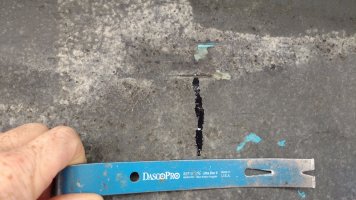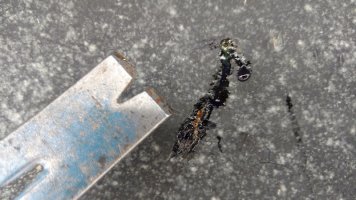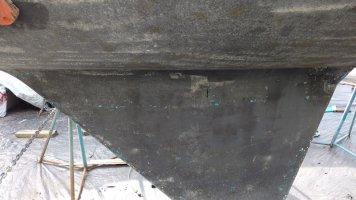I have an unusual situation a the keel joint. At least its unusual to me. The boat has been on the hard for a month. I just noticed what appears to be a sap like substance coming out of the keel joint at the exact same location on both sides of the boat. There was some minor bubbling/delamination at one of these areas at the haul out, so I suspect some sea water was getting into this area.
This substance just showed up in the last week. Its sticky like sap, dark brown, and smells strongly of epoxy (like when a pot of it goes off too hot). The "soft" spot in the keel/hull joint at this point is only about an inch long on the port side and there is not really a soft spot or bubble on the starboard side, but it is weeping this sticky substance too. The remainder of the keel joint is perfect.

Port side

Starboard Side

Keel joint
Any insight into what this is, and why? And why would it start coming out now, a month after the boat was dropped on the hard? I have not investigated the inside of the bilge yet, but survey found all keel bolts and nuts looked good. There was water in the bilge, which did not appear to be salt water (surveyor tested its resistance). I am going to grind into this area eventually, but figured I would try to arm myself with information first.
I'm really hoping not to have to drop the keel.
Thanks!
This substance just showed up in the last week. Its sticky like sap, dark brown, and smells strongly of epoxy (like when a pot of it goes off too hot). The "soft" spot in the keel/hull joint at this point is only about an inch long on the port side and there is not really a soft spot or bubble on the starboard side, but it is weeping this sticky substance too. The remainder of the keel joint is perfect.
Port side
Starboard Side
Keel joint
Any insight into what this is, and why? And why would it start coming out now, a month after the boat was dropped on the hard? I have not investigated the inside of the bilge yet, but survey found all keel bolts and nuts looked good. There was water in the bilge, which did not appear to be salt water (surveyor tested its resistance). I am going to grind into this area eventually, but figured I would try to arm myself with information first.
I'm really hoping not to have to drop the keel.

Thanks!
Attachments
Last edited:




